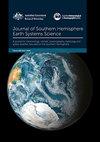Atmospheric rivers in the Australia-Asian region: a BoM–CMA collaborative study
IF 3.6
4区 地球科学
Q1 Earth and Planetary Sciences
引用次数: 18
Abstract
The name ‘atmospheric river’ (AR) could easily be misinterpreted to mean rivers flowing in the sky. But, ARs actually refer to narrow bands of strong horizontal water vapour transport that are concentrated in the lower troposphere. These bands are called ‘atmospheric rivers’ because the water vapour flux they carry is close to the volume of water carried by big river systems on the ground. ARs can cause heavy rainfall events if some physical mechanisms, such as orographic enhancement, exist to set up the moisture convergence and vertical motions necessary to produce condensation. In recent decades, these significant moisture plumes have attracted increasing attention from scientific communities, especially in North America and western Europe, to further understand the connections between ARs and extreme precipitation events which can trigger severe natural disasters such as floods, mudslides and avalanches. Yet very limited research has been conducted in the Australia-Asian (A-A) region, where the important role of atmospheric moisture transport has long been recognised for its rainfall generation and variations. In this paper, we introduce a collaborative project between the Australian Bureau of Meteorology and China Meteorological Administration, which was set up to explore the detailed AR characteristics of atmospheric moisture transport embedded in the A-A monsoon system. The project in China focused on using AR analysis to explore connections between moisture transport and extreme rainfall mainly during the boreal summer monsoon season. In Australia, AR analysis was used to understand the connections between the river-like Northwest Cloud Band and rainfall in the region. Results from this project demonstrate the potential benefits of applying AR analysis to better understand the role of tropical moisture transport in rainfall generation in the extratropics, thus achieve better rainfall forecast skills at NWP (Numerical Weather Prediction), sub-seasonal and seasonal time scales. We also discuss future directions of this collaborative research, including further assessing potential changes in ARs under global warming.澳大利亚-亚洲地区大气河流:boma - cma合作研究
“大气河”(AR)这个名字很容易被误解为天空中流动的河流。但是,ar实际上指的是集中在对流层下层的强水平水汽输送的窄带。这些带被称为“大气河”,因为它们携带的水蒸气通量接近地面上大型河流系统携带的水量。如果存在某些物理机制,例如地形增强,以建立产生凝结所必需的水汽辐合和垂直运动,则ar可以引起强降雨事件。近几十年来,这些显著的水汽羽流引起了科学界,特别是北美和西欧科学界越来越多的关注,以进一步了解ar与极端降水事件之间的联系,极端降水事件可能引发洪水、泥石流和雪崩等严重的自然灾害。然而,在澳大利亚-亚洲(A-A)地区进行的研究非常有限,在该地区,大气水分输送的重要作用长期以来一直被认为是降雨的产生和变化。本文介绍了澳大利亚气象局与中国气象局的合作项目,该项目旨在探索a - a季风系统中大气水分输送的详细AR特征。中国的项目侧重于利用AR分析来探索主要在北方夏季季风季节的水分输送与极端降雨之间的联系。在澳大利亚,使用AR分析来了解河流状西北云带与该地区降雨之间的联系。该项目的结果表明,应用AR分析可以更好地了解热带水汽输送在温带降水产生中的作用,从而在数值天气预报(NWP)、亚季节和季节时间尺度上实现更好的降雨预报技能。我们还讨论了未来合作研究的方向,包括进一步评估全球变暖下ar的潜在变化。
本文章由计算机程序翻译,如有差异,请以英文原文为准。
求助全文
约1分钟内获得全文
求助全文
来源期刊

Journal of Southern Hemisphere Earth Systems Science
Earth and Planetary Sciences-Oceanography
CiteScore
8.10
自引率
8.30%
发文量
0
审稿时长
>12 weeks
期刊介绍:
The Journal of Southern Hemisphere Earth Systems Science (JSHESS) publishes broad areas of research with a distinct emphasis on the Southern Hemisphere. The scope of the Journal encompasses the study of the mean state, variability and change of the atmosphere, oceans, and land surface, including the cryosphere, from hemispheric to regional scales.
general circulation of the atmosphere and oceans,
climate change and variability ,
climate impacts,
climate modelling ,
past change in the climate system including palaeoclimate variability,
atmospheric dynamics,
synoptic meteorology,
mesoscale meteorology and severe weather,
tropical meteorology,
observation systems,
remote sensing of atmospheric, oceanic and land surface processes,
weather, climate and ocean prediction,
atmospheric and oceanic composition and chemistry,
physical oceanography,
air‐sea interactions,
coastal zone processes,
hydrology,
cryosphere‐atmosphere interactions,
land surface‐atmosphere interactions,
space weather, including impacts and mitigation on technology,
ionospheric, magnetospheric, auroral and space physics,
data assimilation applied to the above subject areas .
Authors are encouraged to contact the Editor for specific advice on whether the subject matter of a proposed submission is appropriate for the Journal of Southern Hemisphere Earth Systems Science.
 求助内容:
求助内容: 应助结果提醒方式:
应助结果提醒方式:


